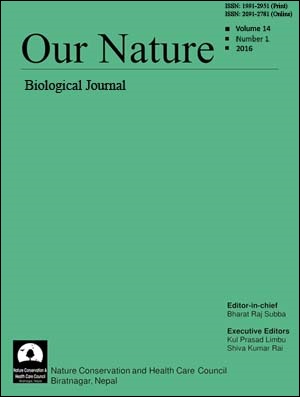Effect of disturbance on litter dynamics in moist tropical forest of eastern Nepal
DOI:
https://doi.org/10.3126/on.v14i1.16435Keywords:
Litter fall, Litter mass, Nutrient stocks, Sunsari DistrictAbstract
Litterfall is an important vector of nutrient and carbon recycling in forest ecosystems. Present study was conducted in moist tropical forest of eastern Nepal to understand the effect of disturbance on litter dynamics. Litterfall was estimated at monthly intervals from one litter trap (1 m × 1 m) at each of the 70 sampling plots while litter mass accumulated at each sampling plot was collected once every season from one 1 m × 1 m plot. The total annual litterfall in undisturbed forest (UF) was 11.8 Mg ha−1 yr−1 which decreased by 54.2% in disturbed forest (DF). Leaves accounted for 69% (UF) to 76% (DF) of total litterfall while non-leaf litter formed the rest. Seasonal pattern exhibited a concentrated litterfall in summer season during March to June when more than 70% litterfall occurred in both stands. Forest floor litter mass also decreased due to forest disturbance. The total input of nutrients to the soil through litterfall in UF was more than double as compared to DF. The nutrient stocks in litter mass were in the order: N > K > P in both stands. Key disturbance activities like lopping, litter removal, tree felling, grazing, fire etc. in the peripheral part of the forest should be strictly prohibited by imposing rules and regulations so that status of biodiversity would be restored.

This work is licensed under a Creative Commons Attribution-NonCommercial 4.0 International License.
Downloads
Downloads
Published
How to Cite
Issue
Section
License
This license enables reusers to distribute, remix, adapt, and build upon the material in any medium or format for noncommercial purposes only, and only so long as attribution is given to the creator.




